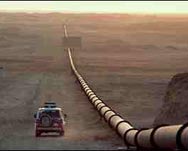
Renewables, please
OPEC is once again under pressure to boost production ahead of a winter supply crunch in northern Europe. The group decided to hike a small amount, an extra 500,000 barrels of oil a day, as of November. ” We don’t see sufficient evidence that there’s a need [for an output hike],” was how Chakib Khelil, the Algerian energy minister, explained the decision last week. “We still have a meeting [in November] and an extra meeting in December where we could make the right decision,” he added.
The market reacted as if nothing had happened: oil broke through the $80 mark on Thursday night.Speaking in Canada last week, Jeroen van der Veer, chief executive of Royal Dutch Shell, said he saw no fundamental reason why crude prices had breached such levels. “There is a lot of psychology in the price,” he said.
Van der Veer has a point, but he would no doubt admit that the era of cheap oil has been over for some time.
While the real price of oil is still shy of its all-time peak, it is getting closer to the levels seen in the 1980s. And now that the barrier of $80 has been breached, there is a growing belief that the day of $100 oil is not that far away.
“It’s not difficult to put together a persuasive scenario where oil prices go slightly higher than $80 a barrel,” says Kevin Norrish of Barclays Capital. According to Norrish, the market fundamentals are enough to support an oil price of close to $80 a barrel; inventories are low and Opec production has not been that high. In addition, there is always a seasonal rise in prices ahead of the winter in northern Europe when companies stock up on crude. It would not take too much – a particularly severe hurricane in America or an outbreak of hostilities in the Middle East – to push prices above $80 a barrel. “The risks are there but the fundamentals are very strong. This is not a speculative bubble,” adds Norrish.
Jeff Currie, head of commodity research at Goldman Sachs, describes it as “a cyclical bull market for oil”. “There is a risk that the oil price will spike to $95 per barrel by the end of this year if the market remains in significant deficit,” he adds.
But what is keeping people like Norrish and Currie bullish on the oil price is the longer-term supply-demand balance. Production growth is slowing within non-Opec countries.
It is in Opec
